At this point, I’ve written about as much of the OOP Fundamentals that I believe are necessary to begin looking at more in-depth topics (such as design patterns and how to apply these topics in WordPress development).
But when planning the content, I kept coming back to a few other things that I think are also necessary to cover eventually. These are things such as Composer, Yarn, build tools, and so on.
Above that, though, I kept asking myself:
If I’m going to be writing about this material at length, should I assume we’re all using the same environment?
And that’s a tough question to answer because some of the people reading this have been writing code for quite some time. That is, they (or you) have your tools, your setup, and how you like to organize your projects.
On the other hand, there are those (or you), who are looking for a different way or looking to start from the ground-up. And to that end, I think it’s important to cover two things:
- How to Setup a Local Development Environment
- What IDE, Add-Ons, and Tools are going to be used
For some, it’s not the most exciting topics and it’s certainly putting a pause on the more advanced aspect of object-oriented programming. Since those of you who pay to read this material have access to the comments, I have to assume that – at some point – comments will come through asking about how to achieve certain things.
And to that end, I’m going to assume that we’re all working off of the same playing field. If not, there’s only so much that I can do to provide help beyond actual programming questions.
So before going any further into the depths of object-oriented programming, I’m going to spend a few posts covering the above topics in detail to make sure that we’re all on the same page.
If you’re comfortable with your tools and your setup, then please bear with me. If you’re looking for a definitive way to setup your environment, then the following posts are for you.
And with all of that said, let’s get started with talking about how to cleanly set up a local development environment that’s easy to maintain.
[restrict paid=”true”]
Continue reading



